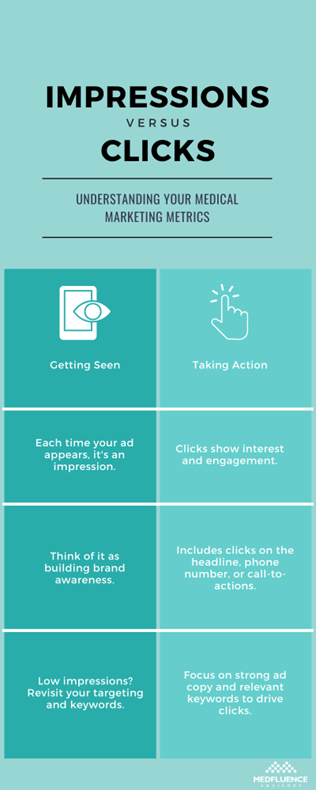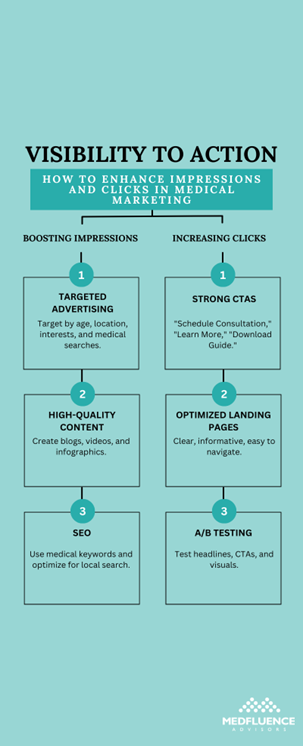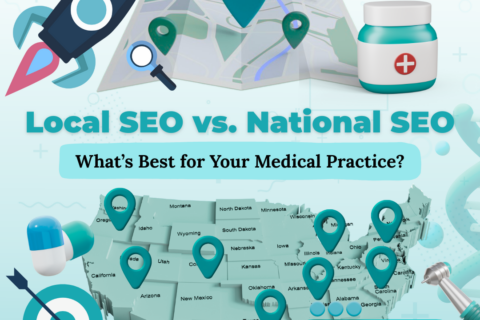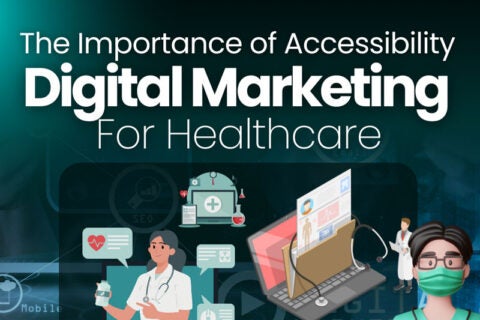Impressions And Clicks: Essential Metrics For Targeted Medical Marketing
You’ve poured your heart and soul into building a medical practice dedicated to providing exceptional care. But in our current digital landscape, where countless healthcare providers vie for attention, how do you effectively connect with the patients who need your specialized services? The answer lies in understanding the power of impressions and clicks. Think of impressions as the times your message has flickered across a potential patient’s screen, and clicks as moments of genuine connection when they decide to learn more. This guide isn’t just about numbers; it’s about understanding how to translate your passion into a digital language that attracts the right patients and allows you to make a real difference in their lives. After all, behind every impression and every click is a person seeking solutions and finding hope within your practice.
Below, you will find the differences between impressions and clicks, their importance for your practice, and how to bolster both in order to reach the right patients.

click here to receive a free
Digital Marketing Playbook
What Are Impressions vs. Clicks?
In the world of medical marketing, impressions and clicks are the two key vital signs that reveal the health of your digital outreach efforts. Let’s break them down:
Impressions
Impressions represent visibility – every time your ad appears on a search engine result page or relevant website, it registers as an impression. Think of these impressions as multiple touchpoints where potential patients can become aware of your practice, even if they don’t click immediately. If you notice your ads aren’t getting enough impressions, it’s a sign to reassess your targeting and potentially adjust your keywords.
Sometimes, only portions of your ad may appear, such as in location-based search results. This is still considered an impression and contributes to brand recognition. Google often abbreviates “impressions” as “Impr.” in your analytics – this metric is crucial for understanding how frequently potential patients encounter your practice online, laying the foundation for future clicks and engagement.
Clicks
Clicks are the lifeblood of successful digital advertising for medical practices. They signify that your messaging resonates with potential patients. Understanding what counts as a click on platforms like Google Ads is key. A click can be triggered by interactions with your ad’s headline, phone number, or call-to-action buttons, even if a user doesn’t immediately reach your website due to technical issues. Remember, clicks on YouTube TV ads are specifically for actions taken on the TV’s call-to-action, not subsequent notifications.
Your ad’s clickthrough rate (CTR) is an incredibly valuable metric for medical marketers. It reveals the percentage of people who clicked on your ad after seeing it. A high CTR demonstrates that your targeting, ad copy, and keywords are working in harmony to attract the right patients. Focus on crafting highly relevant ads that speak directly to your target audience’s pain points and solutions to maximize this essential metric.
The Importance Of Impressions And Clicks In Medical Marketing
In a crowded digital landscape, impressions are the key to ensuring your practice stands out. Every time your targeted ads or content appear, they create an opportunity for potential patients to discover your expertise. Even without an immediate click, repeated impressions solidify your practice’s name and services in the minds of those within your target demographic. This familiarity can influence healthcare choices when a need arises.
Practices focused on specific conditions or specialized treatments such as the medical field benefit significantly from maximizing impressions. By consistently appearing in relevant searches, you become the go-to authority for these niche needs.
Meanwhile, clicks represent a turning point in the patient journey, signaling a potential patient’s active interest and desire to connect with your practice. The use of strategic and compelling calls to action (CTAs) such as “Schedule a Consultation,” “Download Our Guide [to condition],” or “Join Our Email List” is essential to drive clicks and convert interest into action.
Clicks demand a seamless follow-through. Ensure your landing pages are informative, address patient concerns, and provide clear next steps (booking appointments, downloading resources, etc.). In medical marketing, strategic calls to action (CTAs) with well-optimized landing pages encourage prospective patients to schedule consultations, download informational resources, or sign up for email communications.

Click here to receive a free
Digital Marketing Playbook
How To Enhance Impressions And Clicks
While the foundational principles of enhancing impressions and clicks apply broadly, the field of medical marketing necessitates a specialized approach. These are specific tactics that prioritize patient sensitivity and ethical considerations that you need to know:
Boosting Impressions
To amplify your reach and ensure your practice is seen by the right people, focus on:
1. Targeted Advertising
Invest in platforms like Google Ads and Meta Ads (Facebook, Instagram), which offer unparalleled targeting capabilities for medical marketing. These allow you to zero in on:
Demographic Targeting
- Age groups, locations, and other factors relevant to your ideal patient. Focus on age ranges most likely to experience the conditions you treat (e.g., cardiology ads for 45+ age groups).
- Geotargeting allows you to reach potential patients within your service area. Consider expanding your reach to neighboring towns or regions if your practice offers unique specializations.
- Platforms like Meta Ads allow targeting based on life events such as expectant parents for prenatal care ads or interests that indirectly align with health conditions like fitness enthusiasts for sports injury specialists.
Keyword-Based Targeting
- Target those actively searching for treatments, solutions, or doctors specializing in your niche. (e.g., “persistent migraines,” “knee pain after running”).
- Focus on condition-specific searches. Capture those actively researching diagnoses (e.g., “endometriosis symptoms,” “ADHD treatment options”).
- You also try competitor targeting. But, a word of advice, use it with caution. Strategically target keywords related to competitor practices to be seen as an alternative option.
Search vs. Display Network
- Reach individuals searching for information on specific diseases or symptoms.
- Google Ads offers a distinction between ads appearing on Search Engine Result Pages (SERPs) and those displayed on partner websites within the Google Display Network. SERP ads typically target high-intent searches, while display can boost brand awareness.
- Meta Ads places your ads across its network of social platforms, allowing for engaging formats like video or carousel ads.
2. High-Quality Content
Become a trusted resource for potential patients by:
- Addressing common concerns, answering questions, and showcasing your expertise through blog posts.
- Research forums, social media groups, and ‘frequently asked questions’ sections of competitors to understand your target audience’s worries and knowledge gaps.
- Provide detailed, empathetic answers to common queries. (e.g., “What to Expect During Your First Cardiology Appointment”, “Living with Chronic Pain: Management Strategies and Support” ).
- Weave in your practice’s unique approach, technologies used, and specializations within these articles.
- Use engaging videos to explain procedures, offer patient testimonials, or provide practice tours.
- Short videos demonstrating preparation for common procedures or explaining how equipment works can ease patient anxiety.
- Feature patient testimonials (with consent), focusing on how your practice improved their quality of life.
- Give potential patients a sense of your facility’s atmosphere and introduce your friendly staff.
- Providing shareable infographics to break down complex medical topics into easily understood visuals.
- Infographics can simplify anatomical explanations or illustrate the progression of a disease.
- Help patients understand their options with clear charts comparing different treatments, medications, or therapies.
- Employ visually appealing designs and clear fonts, encouraging social sharing, which in turn boosts your online visibility.
3. Search Engine Optimization (SEO)
- Medical Keywords: Integrate relevant keywords patients use into your website and content to boost your visibility in search results.
- Keyword Research Tools: Utilize platforms like SEMrush or Ahrefs specifically focused on medical searches to identify high-value, relevant terms.
- Go Beyond Symptoms: Target keywords related to treatment options, specialized care, and questions like “best [procedure type] near me”.
- Natural Integration: Weave keywords organically into your content, headlines, and image descriptions (alt-text). Avoid keyword stuffing, as it can hurt your search rankings.
- Local SEO: Ensure patients in your area can easily find your practice by optimizing for local searches (e.g., “dermatologist near me”).
- Google My Business: Claim and fully complete your listing, it’s a primary source for local searches. Encourage patient reviews to boost visibility.
- Location-Specific Pages: Create individual pages for each location if you have multiple offices.
- Local Citations: Ensure your practice’s name, address, and phone number (NAP) are consistent across reputable directories and healthcare listings.

Click here to receive a free
Digital Marketing Playbook
Increasing Clicks
Driving action and lead generation requires:
1. Strong Calls to Action (CTAs)
- Focus on the benefit the patient receives by clicking.
- Instead of “Schedule a Consultation,” try “Find Relief from [Condition] Today.”
- Replace “Learn More…” with “Discover the Latest [Condition] Treatment Options.”
- Start your CTAs with powerful verbs that inspire immediate action.
- Consider: “Book,” “Reserve,” “Explore,” “Start,” “Claim,” “Get.”
- Urgency and specificity
- Add time-sensitive language: “Schedule Your Appointment Now,” “Limited-Time Offer”
- Be specific about the offer: “Download Our Free Guide to Managing [Condition].”
- Personalization (where possible): If your technology allows, tailor CTAs based on the patient’s known need. For example, a returning visitor searching for follow-up information could see a CTA like “Schedule Your Follow-Up Consultation.”
You can also try these additional CTA Strategies:
- Placement and prominence: Place CTAs strategically on your website and ads where they stand out without being intrusive.
- Design matters: Use contrasting colors and clear fonts to make your CTAs visually appealing.
- Consider Multiple CTAs: Offer different CTAs based on the potential patient’s stage in their journey (e.g., “Learn More” for early searches, “Book a Consultation Now” for those ready to take action).
2. Optimized Landing Pages
Design landing pages that seamlessly convert interest into action:
- Provide value by expanding on the information promised in your ad or CTA
- Message Match: Ensure the landing page headline and content directly align with the ad or CTA that brought the user there. Avoid jarring discrepancies that cause potential patients to leave immediately.
- Deliver on the Promise: If your CTA advertised a free patient guide, make it immediately accessible. If it promised information on treatment options, provide a clear overview.
- Go a Step Further: Add additional value that wasn’t explicitly mentioned in the ad, such as a brief explainer video, a relevant FAQ section, or further resources.
- Are visually appealing and easy to navigate
- Clean Design: Avoid cluttered layouts and distracting elements. Focus on clear headlines and well-organized information.
- Professional Imagery: Utilize high-quality photos or videos that reflect the positive and reassuring atmosphere of your practice.
- Intuitive Navigation: Limit menu options on landing pages to focus the user on the desired action. Keep the path to booking a consultation or downloading resources exceedingly clear.
- Clearly outline the next steps a potential patient should take
- Prominent Primary CTA: Make your “Book Your Appointment” or “Download Guide” button stand out visually, and place it above the fold (immediately visible without scrolling).
- Limit Distractions: Avoid adding too many secondary CTAs or links that could divert the potential patient’s attention from the primary action.
- Reinforce Trust: Include patient testimonials, success rates (if applicable), and any relevant accreditations or certifications that establish your practice’s credibility.
3. A/B Testing
Continuously refine your approach by:
- Testing different variations of headlines and CTAs to find what works best.
- Headline Hypotheses: Test variations in tone, length, and benefit emphasis. For example, “Manage Your Chronic Pain” vs. “Find Lasting Relief from Chronic Pain Today”.
- CTA Experimentation: Experiment with verbs, urgency, and personalization. You can try using “Schedule Your Consultation” vs. “Start Your Journey to Pain Relief Today”.
- Test One Element at a Time: Avoid changing multiple variables simultaneously, as this makes it difficult to isolate what drives improved performance.
- Comparing visual elements (images, videos) to gauge what resonates with your audience.
- Image Impact: Test the effectiveness of:
- Professional staff photos vs. patient-focused images
- Stock photos vs. custom photos highlighting your practice
- Images with warmer color tones vs. cooler tones
- The Power of Video: Experiment with short explainer videos, patient testimonials, or virtual practice introductions. Compare engagement metrics (play rate, watch duration) between different video styles.
- Image Impact: Test the effectiveness of:
Additionally, you can follow these A/B Testing best practices for medical marketing:
- Choose the Right Platforms: Many ad platforms, email marketing tools, and website builders have built-in A/B testing functionality.
- Set Clear Goals: What’s your primary metric for success (CTR, open rate, conversions)? Define this before you start testing.
- Statistical Significance: Run tests until you reach a statistically significant sample size to ensure your results are reliable. Online tools can assist with calculations.
- Iterative Process: A/B testing is not a ‘set it and forget it’ tactic. Use the insights from each test to inform the next round for continuous improvement.
In medical marketing, the quality of engagement often matters more than sheer quantity. Prioritize patient-centric content that helps you build trust while strategically enhancing impressions and clicks.

Click here to receive a free
Digital Marketing Playbook
Reaching Patients, Changing Lives

By strategically maximizing impressions and clicks, you’ll ensure your practice reaches the right patients and empowers them on their journey toward health. Remember, behind each metric is a person seeking care. By combining data-driven insights with the empathy that defines exceptional medicine, you’ll create a practice that attracts ideal patients and makes a profound difference in their lives.


